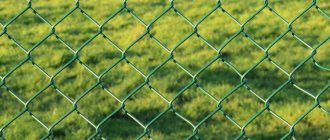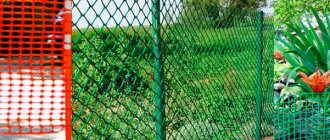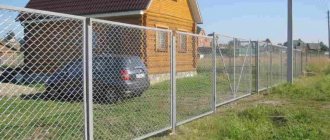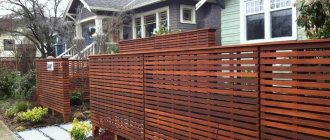Each owner of a home or a plot of land strives to designate the perimeter of his territory. For this purpose, various fences are built from brick, stone, wood or metal, but their construction is very expensive. The way out of this situation is to build a fence using a chain-link mesh. This material is so easy to install that it is quite possible to handle it with just one pair of hands. The result is a reliable and, at the same time, lightweight fence. So what is chain-link mesh?
Characteristics of chain-link mesh - pros and cons
The mesh was named after its inventor, the German Karl Rabitz, who patented a mesh weaving machine in the 19th century. Since then, the production and use of this material has become widespread.
Chain-link is used not only for fences or fences. It is used for sifting bulk materials, reinforcing structures, making cages or enclosures, strengthening mines and slopes.
The chain-link is produced in accordance with GOST 5336-80 in the form of rolls up to 2 m wide and 10 m long. Wire diameter is 1.2-5 mm, cell side (mesh number) is 5-100 mm. Cells can be square or diamond shaped.
Advantages of chain-link fencing:
- ease;
- air and light permeability;
- low windage;
- simple installation;
- sufficient strength;
- durability (subject to high-quality protective coating).
If the mesh is cheap and manufactured in violation of technology, the following disadvantages may appear:
- instability to corrosion and rapid rusting;
- low strength;
- short service life.
For fences and fencing, chain link No. 15-No. 50 with a weight of 1.77-2.44 kg per 1 square meter made of wire with a diameter of 1.4-3.0 mm is mainly used.
Project Definition
At the initial stage, you should determine the installation location of the country fence, the surrounding landscape, terrain features, the length of the fence and the possibility of attaching posts. Additionally, you need to decide what type of fastening and frame will be used. The following options are available to you:
- Tensile structure. Requires the installation of supports on which the chain-link is pulled. The cost of construction is minimal, but the material will sag over time.
- Tension fencing with a wire broach. It eliminates sagging.
- The sectional option is more expensive and reliable, requiring the installation of a special corner for the frame.
Types of chain link
Depending on the purpose, the mesh is made of ordinary uncoated steel or galvanized wire. In more aggressive conditions, polymer-coated wire is used.
Non-galvanized
This mesh is made from black untreated metal. It is afraid of humidity, and after the first rain or fog it becomes covered with rust. Its scope of application is reinforcement of reinforced concrete structures and plaster, fastening of thermal insulation and other work where the metal does not come into contact with a humid environment or only contacts for a short time.
Non-galvanized mesh is inexpensive, which is what attracts summer residents to it. When installing a fence, it is recommended to cover it with waterproof metal paint or a water repellent. Protection needs to be updated at least once every 1-2 years, which, of course, increases the cost of operation.
Galvanized
A galvanized wire chain-link can last 20 years or more. The best way to protect steel is hot-dip galvanizing. An important characteristic is the thickness of the zinc layer, which is determined by the mass value per square meter and averages 70-90 g/m².
The second most reliable method is the galvanic method. The thickness of zinc during electrochemical processing is less than during hot-dip galvanizing, but it also ensures a fairly long service life of the material.
Corrosion of galvanized mesh in the first months of operation is the result of the fact that there is not enough zinc on the wire - 10 g or less. It can only be called galvanized formally. When purchasing, pay attention to this important factor.
Plasticized
The chain-link mesh with a protective polymer coating is decorative and at the same time very resistant to corrosion. This material is used in humid climates, including on the sea coast. Modified PVC is used for processing. It is evenly sprayed onto the metal surface, creating a sealed, resistant film.
High-quality polymer coatings do not crack from frost or heat, and do not fade. The mesh retains its appearance and technical characteristics for a long time.
Selecting a suitable mesh
Chain-link is made from different raw materials, has differences in the diameter of the cells, type of coating, which is why it has a wide range of applications. Let's look at the main types that are most suitable for fencing.
Photo: mesh fencing on a metal frame
Metal type
Happens:
- stainless steel;
- made of low carbon steel.
In the first case, the material has increased rigidity, so it is more often used for fences.
Cell size
Available in diameters from 25 to 100 mm. Moreover, the larger the dimensions of the cells, the lower the price, but the load-bearing capacity of the mesh is also low. A product with a small cell will be heavier in weight, because more metal is spent on it, and therefore cost more.
Photo: cell shape - a method of weaving a chain-link. On the left is rhombic, on the right is square.
On the border with the neighboring plot, it is recommended to install a chain-link fence with a diameter of 40 mm to 60 mm. If this is a fence for poultry (chickens, ducklings), then the mesh should be taken with a fine mesh of 25, 30 mm.
Coating
There are three types:
- Non-galvanized. The cheapest due to its fragility. Has a tendency to corrosion. To avoid this, the mesh must be painted immediately after fastening. The layer will have to be updated once every 2-3 years. Cell size from 50 to 100 mm. The thickness of the wire used is 1.2 – 5 mm.
- Galvanized. The steel mesh is coated with zinc, which makes it durable and resistant to environmental influences. Does not require maintenance. The cell diameter ranges from 50 to 100 mm. Wire thickness - 1.6 - 5 mm.
- Plasticized or with polymer protection. Covered with a layer of PVC. It has a neat appearance and a large selection of colors. The service life is much longer than the first two types, but the price is higher. Wire thickness is from 2.5 to 2.8 mm. Cell diameter is from 25 to 50 mm.
Photo: woven mesh with polymer coating
Advice from builders: when buying a polymer-coated chain link, ask the seller for a quality certificate and a warranty card. A product with a regular PVC layer, without protective additives, will be inexpensive, but after 2 years it will become unusable, causing cracks on the surface.
How to make a chain-link fence: fastening methods
The main 3 options for installing the mesh are tension with or without guides, as well as the production of individual sections, which are subsequently attached to the supports.
Tension without guides
The simplest and most economical way to build fences where there are no requirements for appearance. The fact is that this design does not look very decorative and often sag over time.
Tension mounting technology without guides:
- Install pillars.
- Attach the roll to the first support.
- Stretch the mesh and fix it sequentially to each rack.
- Attach the chain-link to the last post, cut off the excess.
The two rolls are connected to each other with wire, which is unscrewed from the edge of the chain-link. The mesh is positioned so that the top and bottom coincide, and the convex part of the cells faces one way. Using a rotational movement, insert a spiral behind the wall of each cell and evenly weave them one after another.
Clamps, tension couplings, staples, hooks, self-tapping screws with overlays, and vertically welded rods are used as fasteners.
Stretch with guides
This is a more labor-intensive method that ensures minimal structural rigidity. The guides keep the chain-link tensioned and prevent it from stretching and sagging. During installation, a metal cable, slats, thin pipes or fittings are passed horizontally through the cells, which create the necessary support for the mesh.
When installing pillars, you need to provide some kind of device for fixing the veins. If it is a metal cable, a nut is welded to the support or a through hole is drilled. Some manufacturers produce poles with hooks already welded on.
A fence with guides can be mounted in two ways:
- first tension the mesh and secure it to the supports, and then pass the guides;
- install the guides, and then attach the mesh to them.
If a profile or reinforcement is used as guides, they are passed through the mesh cells and welded to the posts. The protruding wire is bent down.
Sectional fence
This method is more complex and time-consuming than the others. But the fence turns out to be rigid, durable and neat.
Diagram of a sectional chain-link fence
A rectangular frame is pre-prepared from corners, pipes, and fittings. The mesh is cut to the size of the section and fixed to the frame in one of the following ways:
- using hooks;
- fastening strips;
- welding the reinforcement rod.
The finished sections are attached to plates welded to the posts. Gates and wickets are made in the same way, they are then hung on hinges.
Final finishing - decoration, photo
A fence built with your own hands using chain-link mesh has a neat appearance, but nothing more. Over time, the desire arises to somehow decorate it. You don't have to be an artist or designer to do this. It is enough to show your imagination, and your fence will become a piece of art.
The easiest way to transform a fence is to plant climbing plants next to it. In a few months, your fence will turn into a flowering wall. The pillars can be decorated with clay pots, this will give the fence ethnic beauty.
Fence cells can be turned into canvas for embroidery. Just like drawing on a canvas, you can weave beautiful patterns with your own hands. For this you will need wire. If you use colored twine, then with its variety of colors and shades you can create three-dimensional images.
Recently, it has become popular to decorate the fence with a photo grid. The drawing can be absolutely anything. The peculiarity of this material is that from a distance a continuous pattern is visible, but in fact it consists of a fine polymer mesh, which is perfectly ventilated.
Wire resembling lace is an interesting option for those who have nothing to hide
Painted roses look elegant. The main thing is that the drawing on the photo grid matches the landscape
Wide grape leaves will decorate and hide the area from prying eyes
How and with what to close the fence from neighbors: options with photographs
Since a chain-link fence is completely transparent, any home owner will want to hide it from prying eyes. It is not advisable to cover it with any shields or boards.
The easiest way is to cover the fence with camouflage netting. Visibility through the fence will be much less, but the appearance will also be unattractive.
You can cover the fence with reed mats. This method is more expensive than the previous one. Attaching them is not difficult; you just need to unwind the roll and secure it in several places with wire.
A similar option is to use artificial pine needles. This material is sold in rolls. It is used in making wreaths and baskets, but it can also be used for fencing.
A fence that is covered with a camouflage net looks aesthetically pleasing only if you are in a paintball zone
Rolls of reeds are a more expensive option
The use of artificial needles looks original
Pillars
Wooden, metal or asbestos-cement supports are often used as supports, less often concrete or brick.
Tree
The weight of the chain-link mesh is small, the wind load is low. Wooden poles can handle it quite well. They are inexpensive, but less durable than metal or stone. They are made from sanded logs or timber. It is recommended to coat the lower part with heated bitumen and wrap it in roofing felt, and treat the upper part with an antiseptic.
Before installing the supports, prepare holes or holes with a diameter exceeding the cross-section of the pillar by 15-20 cm and a depth of 0.7-1.2 m. The installation step of the supports is 2.5 m.
The racks are fixed vertically. The pit is filled layer by layer with crushed stone and sand, spilled with water, and compacted. The mesh can be attached to wooden posts with ordinary nails, bent with a hammer.
Metal
The supports are made from profile pipes with a cross-section of 40x40 mm or more or round pipes with a diameter of 45 mm or more. The racks are installed by driving, backfilling or partial concreting.
The depth of immersion of the base of the pillar is 0.7-1.2 m, step 2-3 m. If concreting was carried out, you need to wait 1-2 days until the concrete has completely set, and then attach the mesh.
It is recommended to pre-treat the metal against rust and prime it. To prevent precipitation from entering, the holes must be welded or plugs placed on the posts.
Asbestos cement pipes
Asbestos cement posts are a popular material for making fences. They are not afraid of frost, fire and moisture. Due to their fragility, they must be handled with care.
To fasten the chain-link, posts with a diameter of 100 mm and a length of 2950 mm are used. They are dug in to a depth of 1-1.2 m, the base is covered with crushed stone or concreted. It is recommended to attach a cap on top to protect against water ingress. The chain-link fence posts themselves do not need to be filled with concrete. They stand for years without additional reinforcement. The load is small, so no destructive forces are created in the pipe walls. The material of the veins and the method of their fastening have a much greater influence. It is necessary to avoid rigid metal connections, where critical stresses can arise due to large differences in the coefficients of thermal expansion.
Concrete
Concrete pillars are strong, durable supports designed for high loads. They are made by pouring at the installation site, assembled from blocks, or purchased ready-made.
Installation of monolithic pillars is long and labor-intensive. Requires installation of formwork and reinforcement cage, preparation and pouring of concrete. Strengthening time is 3-5 days. After this, the structures are demolished and further installation is carried out.
Prefabricated pillars are laid out from concrete blocks. They are permanent formwork with ready-made decorative finishing. Installation also requires installation of a reinforced core and pouring concrete, but externally such pillars are much more attractive.
Brick or stone
Supports made from these materials look impressive, they are durable and reliable. Due to the large mass of the pillar, a solid reinforced concrete foundation is required. It is laid below the freezing point.
For columns, both facing brick and ordinary brick with subsequent finishing are used. Masonry is quite labor-intensive and requires highly qualified craftsmen. In areas where building stone is mined, it is also used for fences. Due to the irregular shape of the stones, laying out the column is not easy. Masters use various technologies. For example, a mass of stones and mortar is placed in formwork. After the cement has set, the formwork is removed and each stone located on the surface of the pillar is carefully cleaned with a chisel.
Preparatory actions for construction work: calculating the area of the future fence
Before you begin calculating the area of the future fence, you need to establish what type of foundation will be used. Since the mesh has a relatively light weight, the load on the supports will be insignificant. Therefore, heavy concrete bases are usually not used for chain-link fences, but this also depends on the preferences of the owner.
An important point will be to study the soil in which the pillars are dug or the foundation is laid:
- If it is rocky soil, then there is no point in spending money on a concrete base, since the installed pillar will not deform over time.
- If clay soils predominate at the building site, then the gap between the pillar and the hole must be reinforced with gravel or filled with concrete.
- If the fence will be installed in an area whose soil contains a large amount of sand, then it is necessary to use a strip base.
When studying the soil, it is necessary to determine the freezing point, since installing a post above it will lead to deformation of the fence at low temperatures.
Calculating the area for the fence will not be difficult. For a simpler calculation, just multiply the length by the width of the foundation.
The width of the strip-column base should be at least 25 - 30 cm, and the length, for example, 30 m. We make the calculation: 0.4·30 = 12 m2 - this is the total area of the strip base of the chain-link fence.
When pouring a strip base, for the purpose of strengthening, the size of the foundation for each support is made wider than the gap between them. For more accurate measurements, it is necessary to add up the areas of the base of all the pillars and the areas of the spaces between them. For example, the size of the base of the pillar is 40x40 cm, and the gap is 30x215 cm.
Tape-column base: calculation diagram
To calculate the total area of this foundation, you need to find out the values first for the bases of each support, and then for all the intervals. There are 12 supports (pillars) for this fence. Therefore, the length of the base for the pillar must be multiplied by the width, and the resulting result multiplied by the number of supports: 0.4·0.4·12=1.92 m2 - this is the total area of the base for the pillars (supports). The area for the gaps is also calculated, only you need to multiply by one less: 0.3·2.15·11=7.09 m2. Now we need to add up the results obtained, and we will get the total area for the entire tape: 1.92 + 7.09 = 9.01 m2.
What material is suitable, the dimensions of the fence mesh. Tips for choosing
Chain-link mesh is manufactured in different sizes, which are standard. Chain-link with mesh sizes: 0.4x0.4 cm, 0.5x0.5 cm, 0.6x0.6 cm, as well as options with intermediate sizes: 0.45x0.45 cm, 0.55x0.55 cm have found wide application. In terms of roll height (mesh width), this material has dimensions: 120 cm, 150 cm, 180 cm and 200 cm. The length of the mesh web also has established standards. A mesh of 10 or 15 meters in length is rolled up in a roll.
Some manufacturers produce chain-link mesh in non-standard sizes. In this case, the material can be up to 4 m high, with cell sizes from 30 mm to 150 mm.
When purchasing a chain link, you need to pay attention to the thickness of the wire and the quality of the metal. It shouldn't bend easily. The mesh cells must be identical, since any deformation is a sign of low quality metal. Spirals should not be twisted. If you do not take this defect into account, then after a few months the wire in this place may burst.
When purchasing this material, you need to look at both edges of the roll. Each end of the wire must be connected to the adjacent element and bent. The length of the bent “tail” of the wire should be more than half the cell. Otherwise, the edges of the stretched mesh may unravel after some time, which will lead to its deformation.
If the choice is made on a plastic-coated mesh, then in the cheap version it will bend easily. Inexpensive mesh options are coated with low-quality polymer, which can crumble after a few seasons. In this regard, it is necessary to clarify the warranty periods established by the manufacturer.
An inexpensive option is non-galvanized mesh. The main enemy of this type of mesh is moisture. In this regard, after installing the fence, you need to take care of painting it.
All this suggests that when buying this material you should not choose cheap options.
Carrying out calculations of the required material. Calculation examples
To build a fence using chain-link, it is necessary to determine:
- type of material used;
- the width and length of its canvas;
- number of supports;
- type of foundation and required volume of concrete mixture, if a permanent foundation is selected;
To construct a fence from this mesh, you need the following materials:
- The slave herself.
- Metal channel.
- Concrete mixture marked M200.
- Wide wooden boards or sheets of plywood for making formwork.
- Bolts, nuts.
- Wire, metal fasteners and clamps.
- Reinforcing bars.
- Sand.
- Crushed stone.
- Anti-corrosion primer.
- Dye.
To build the fence, a chain-link with a polymer coating will be used, with a cell width of 40x40 mm and a wire thickness of 3 mm. The width of the fabric in a roll is 150 cm, length is 15 m. Channels with parameters 50x50x2400 mm are used for the pillars. To install this type of fence, a strip foundation will be poured. The length of the fencing section is 30 m.
Having established what materials will be needed when building a fence with chain-link, you should proceed to calculations. First you need to calculate the total amount of concrete for the permanent foundation. To do this, you need precise parameters for the length, height and width of the base. Since the foundation under the pillars is wider than under the fence span, each of them will be calculated separately.
Concrete piles will further strengthen the base of the pillars
The calculation of the concrete base for a chain-link fence will look like this:
- To determine the volume of concrete for the base of one pillar, you need to multiply its length, width and height: 0.4·0.4·0.4=0.064 m3.
- To calculate the volume of concrete for one pile, you need: 0.15·0.15·0.5=0.011 m3.
- Now you need to add these values: 0.064·0.011=0.075 m3 - this is the volume of concrete required for the foundation of one pillar.
- In 30 meters of the future fence there will be 12 bases for pillars and 11 for spans. Therefore: 0.075·12=0.9 m3 is the total volume of the foundation for all pillars.
In the same way, it is necessary to make a calculation for 11 spans between the pillars. According to the diagram, the distance between the bases of the pillars is 2.15 m, therefore: 0.3 2.15 0.4 = 0.258 m3 is the volume of concrete for one span. For all spans: 0.258·11=2.838 m3.
Next, you need to find the total value for the concrete required to lay the entire foundation. To do this, you need to add up the total values for the pillars and spans: 0.9 + 2.838 = 3.738 m3.
To calculate the total length of the chain-link, you need to multiply the distance between the metal channels by the number of spans: 2.5 11 = 27.5 m.
Required Tools
When building a fence using chain-link, you will need the following materials:
- Hand drill or screw shovel.
- Shovel and bayonet shovel.
- Cord and stakes.
- Concrete mixer.
- Pliers.
- Metal scissors.
- Welding machine.
- Building level.
- Plumb.
- Yardstick.
- Metal brush.
- Paint brushes and roller.
- Hammer.
- Nails.
- Buckets and tanks for water and concrete mixture.
An easy way to build a fence is to stretch the mesh along the posts, with direct fastening. This method is not particularly reliable.
More suitable for cases where the fence is planned to be temporary. Sagging occurs very often; pulling the wire through the mesh around the entire perimeter will help correct the situation.
How to calculate the amount of materials
At the first stage, the number of supports is determined. To do this, the perimeter of the site or the length of the segment where the fence is to be installed must be divided into increments of 2-2.5 m plus one post for the last point. If the fence has a gate or wicket, it is necessary to take into account the posts for each opening.
The length of the mesh is equal to the length of the fence. It is not difficult to convert into rolls - the length must be divided by the standard size of 10 m. The resulting number should be rounded up.
Depending on the method of fastening, fasteners are selected and calculated. Guides, if used, are needed as many as there are spans in the fence. If they are mounted in 2 rows, then the quantity is multiplied by 2.
To manufacture sections, determine the consumption of angles or pipes for each element and mounting plates at the rate of 2 per support.
Additional materials for foundation construction, primer, paint, protective caps, fittings for gates and gates are taken into account.
Manufacturing of tension fence
This is a simple and economical way to install a chain-link fence with your own hands, for which you will need:
- profile or round pipes for racks;
- net;
- clamps or hooks;
- drill, shovel;
- tape measure, bubble level or plumb line;
- crushed stone, sand, water;
- Bulgarian;
- anti-corrosion agent.
Site marking
Before installation, the fence line is cleared, freed from excess vegetation, and large mounds are cut off. A cord is pulled between the extreme points and the installation locations of the supports are marked in increments of 2-2.5 m along a plumb line.
Pit preparation.
Using a hand or gasoline drill, holes are made at marked points to a depth of 0.7-1.2 m. First, the blades are rotated in one direction, then in the other. The soil from the hole is discarded. Add crushed stone to the bottom in a layer of 10 cm and compact it with a long crowbar.
Installation of poles
The pipes are treated against rust and primed. After drying, the primers are installed in the wells strictly vertically. If there is no assistant who could hold the pole, it is fixed with improvised materials. The following operation is carried out depending on the chosen method of foundation construction:
- butting - crushed stone is covered in layers, each compacted with a crowbar;
- partial concreting - first, concrete is poured to 2/3 of the height, crushed stone is poured on top;
- full concreting - the hole is filled with concrete, pierced with a rod to release air bubbles.
On dry soils with low groundwater levels, pipes can be installed by plugging. To avoid flattening the top of the stand with a striking tool, a metal “glass” is placed on it.
Fastening the mesh
After the concrete has hardened, a mesh is fixed to the outermost column. The reinforcement is threaded into the cells and hooked. You can weld the rod to the stand.
The roll is unwound 2.5 m, tensioned and sequentially secured to the racks using clamps, hooks, screws with overlays or other devices.
If it is unsafe to install mesh on clamps in your area, you can pass a steel rod through the cells and weld it to the post after 20-30 cm. Another way to prevent the theft of the mesh is to use anti-vandal nails or hardware with tear-off caps.
It is not recommended to outline corners with a solid canvas. The mesh must be cut and secured thoroughly on both sides of the post separately.
Installation of a sectional fence
Marking and installation of supports is carried out similarly to a tension fence. A pair of plates with a thickness of at least 4-5 mm are first welded onto each post, to which the sections will be attached.
Frame assembly
To make a frame, corners are cut according to the size of the section:
- the length is equal to the pitch of the pillars minus 10-20 cm;
- height - length of supports minus 15-20 cm.
The frame is welded and polished. You can weld hooks to attach the mesh.
Section preparation
We will tell you how to secure a chain-link using reinforcing bars and welding. This method is convenient because the mesh is often tangled and its edges are uneven. The rods will help not only fix, but also evenly tension the mesh.
The chain-link is spread horizontally, a Æ 6 mm rod is inserted into the outer cells. Stretch the roll to the required length. Place the mesh on the frame. Align the edges. If any wire has become untwisted, it is twisted in a circular motion around the axis.
To prevent the mesh from getting tangled, weld the rod to the corner, cutting off the excess. The step between the welding points is 25-30 cm. Slightly pulling the chain-link, measure the required length. Unscrew the wire, thus disconnecting the fabric. A rod is inserted and secured by welding to the frame.
On the sides of the mesh, the wire is aligned and bent with pliers. The rods are threaded into the cells, cut to size and welded. Clean the seams from scale and prime them.
Installation
The section is installed vertically into the fence span. For fixation, you can use 2 methods:
- welding - the frames are welded to the plates, aligning the top edge horizontally;
- assembly - drill holes and tighten with bolts and nuts.
Welded seams are ground, all sections and pillars are coated with a primer, if this has not been done previously, and finally painted.
One part of the hinge is welded onto the gates and gates, and a counter part is welded onto the post. The panels are hung and adjusted for height and uniformity of movement.
If the area is flat, the level of adjacent fence elements should match. When there is a difference in height, the sections are secured with “steps”.
Installation in problem areas
Even if the terrain in the area is difficult, it is quite possible to stretch a chain-link mesh onto the poles. To do this, the fence is laid out in an area where the height of the supports will be approximately the same. In the first section, the mesh is fastened with normal tension (with or without guides).
At the point of support between two sections of different heights, the roll is first unraveled by unscrewing one wire, then woven lower or higher. The mesh is fixed and continued to be pulled further. In this way, the integrity of the fence will be maintained. At the bottom of the fence you can install a concrete plinth, which will level the terrain and close the empty gaps.
How to decorate a chain-link fence
Since the fence has a rather monotonous appearance, it is decorated in various ways:
- climbing plants are planted nearby;
- weave colored ribbons, wire, bamboo;
- use shading nets and camouflage nets;
- attach a photo panel;
- decorated with various hand-made products.
An important condition is that the materials must be light and resistant to atmospheric conditions. If the mesh was mounted without guides, it may not withstand a large mass and sag. The decor must be attached firmly so that a gust of wind does not tear it off.
Fence decoration options
A mesh fence can serve not only as a fence for a site, but also as its decoration. For this, various methods and materials are used. One simple option is to plant climbing plants along the entire fence line. As the bindweed grows, it will fill the entire area, creating a beautiful hedge.
As special materials for decoration, you can use colored twine or polymer ribbons, using them to create a variety of colored patterns. A simple, although not very fashionable, option is to use a camouflage net. But here it should be taken into account that its elements fade over time in the sun and become covered with a persistent coating of dust.
Among the more modern methods, we can recommend a special photo grid made of polymer materials. It is secured to the surface with eyelets or polymer clamps.











